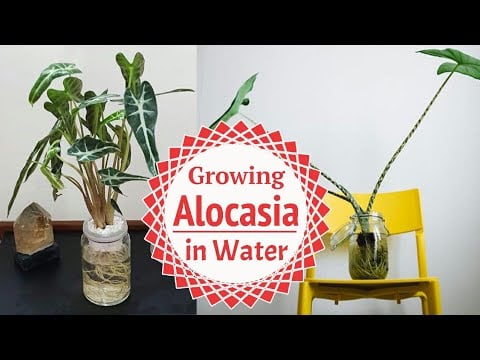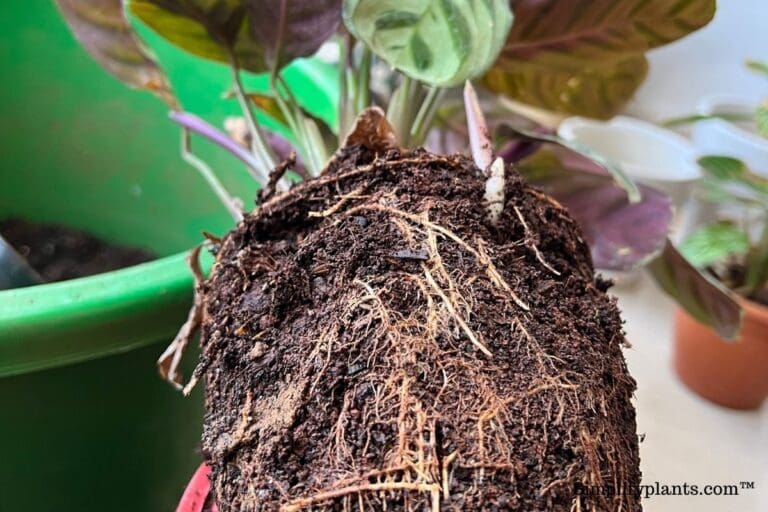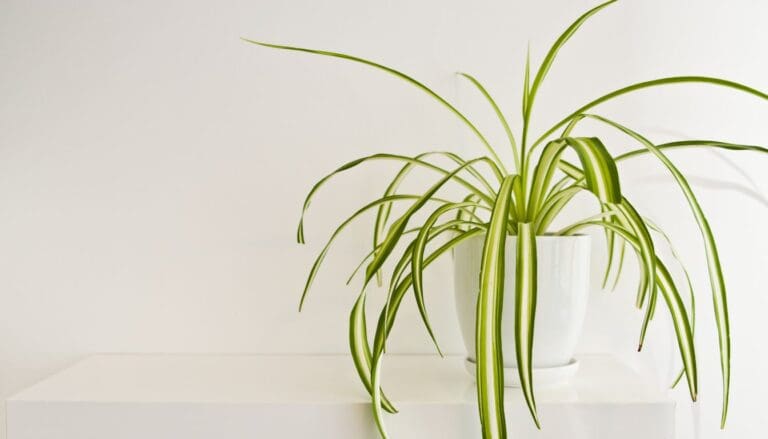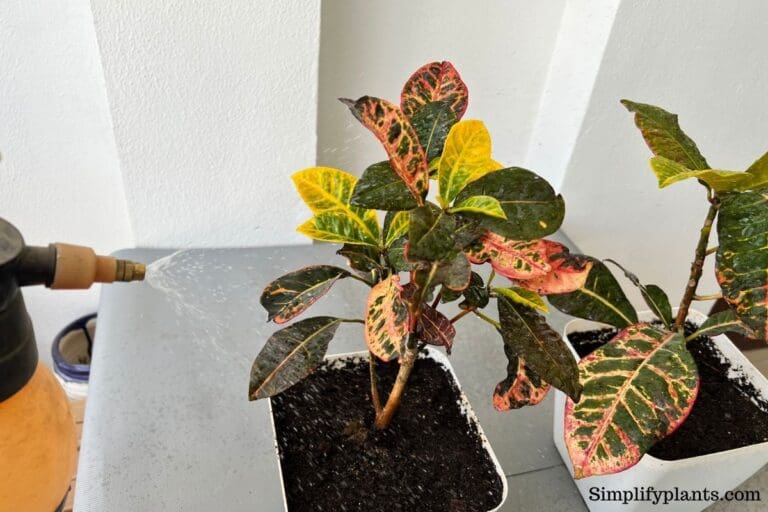Can Alocasia Grow In Water? (How To+Care)
Alocasias are native to the tropical and subtropical areas of Asia and Australia, and they are loved for their large green leaves. Though they flourish in soil, many plant owners wonder whether they can be grown in water. Let’s find out.
To grow an Alocasia in water, you can take it out of its pot, clean the roots, and put it in a container filled with clean water. Taking a cutting from the alocasia and growing it in water will not work. However, you can separate the baby plants from the main plant and grow them in water.
Alocasia will thrive in water if you provide the proper growing conditions like bright indirect light and clean water.
This article will discuss how to grow alocasia in water and the benefits and disadvantages. So, keep reading.

Please note: Simplify Plants is reader-supported. Some links in the post are affiliate links and I get a commission from purchases made through links in the post.
Can you grow alocasia in water?
Alocasia plants are tuberous, meaning they sprout from a central rhizome.
Unlike some other plants, Alocasias grow from bulbs.
So, it is best to cut the baby plants from the bulbs to propagate them instead of cutting leaves or branches.
Leaf or stem cuttings, which are popular ways of propagation, will not be successful in the case of Alocasia plants.
These plants like to grow in clumps, meaning if you remove them from the pot, you will find that they consist of multiple clumps of plants stuck together.
Healthy Alocasias grow from the clumps, are easy to remove from the mother plant and grow in a separate container.
We can grow alocasia in water by propagation, which is quite a simple process.
Growing alocasia in water is satisfying because you see the roots grow gradually.
It adds to the visual appeal of indoor gardens as well.
Once the alocasia has rooted in the water, you can shift the plant to the soil or continue growing it in water.
The choice is yours.
Required elements
Now let us know how you can grow the plant in water and what elements you need to grow your elephant ears in water.
Glass container
You first need a clean glass container to grow your alocasia in water.
You can also use a vase instead.
However, glass lets you see the progress of the roots and the water condition so you know when it is dirty and can change it accordingly.
You need not worry about the container size, but make sure it is not too wide and a little tall so that the plant gets enough support without toppling over.
Water
The water you use for the plant’s growth should be clean and free from chlorine and minerals.
For this reason, it is best to avoid tap water as it is hard water containing minerals like fluorine and chlorine that can harm the plant.
Hard water is not recommended for the healthy growth of plants.
Collecting rainwater is an excellent way as it is rich in beneficial elements for the plant.
However, as it is not always possible, you can use filtered or distilled water.
Or, you can leave the tap water outside overnight to reduce the harmful minerals.
You can then use it to grow your alocasia.
Sharp shears
You need a sharp pair of shears to make sharp cuts to separate a baby plant from the mother plant.
Do not use a blunt knife, which may lead to infections and diseases.
To avoid infections, do not forget to sterilize the shears before and after use.
How to grow Alocasias in water?
Let us now get into the steps of growing the alocasia in water.
Step 1: Remove the plant from the soil.
The first step is to remove the plant from the pot.
Alocasia grows in clusters, and as I mentioned already, taking a leaf or stem cutting will not work for this plant.
So, you must take the plant out of the pot first to put it in water or separate the baby plants.
Step 2: Loosen the root ball
After taking the alocasia out of the pot, dust off the soil, loosen up the roots, and shake them to remove the extra soil.
Wash the roots in running water very well.
Make sure they are clean so that there is no soil sticking to the body of the roots.
If the soil stays clumped to the roots, soak it in water until it is loose and clean.
Step 3: Examine the roots
Once the roots are clean and loosened up, examine them well.
Trim off any dead or decaying roots.
Remove any yellow or dead leaves.
Step 4: Separate the baby plants from the mother plant
Take the sterilized pruning shears and separate the baby plants from the main plant.
Be gentle, as you don’t want to damage the plant.
You can skip this if you plan to put the entire plant in water.
Step 5: Put the Alocasia in water
After taking the plant out of the pot or separating the baby plants, take the container or glass jar filled with water and place it into it.
Make sure the entire root ball gets submerged and does not come out.
Make sure to use only distilled filtered water.
Tap water with chlorine is harmful to the plant.
How do you take care of alocasia in water?

Alocasia thrives happily in water due to its moisture preferences.
If you care for the plant and fulfill its requirements, it will flourish in water.
Let us see what tips you should follow to grow the alocasia in water.
Water quality
Water quality is the most important aspect when growing alocasia in water.
Normal tap water does not benefit your plants because it has impurities and harmful chemicals.
Rainwater is the best as it does not have harmful chemicals and has a lot of essential nutrients for plants.
However, filtered water is the next best option since collecting and storing rainwater is impossible.
If you have water purifiers handy, you can also use that water to grow your plants.
If not, you can fill a container with water and let it sit for 24 hours to remove all the impurities, and then you can use that water.
Change water frequently
When you grow alocasia in the water, you have to keep changing the water from time to time whenever you see it getting dirty.
You have to be regular with this because stagnant water can become a breeding ground for germs and insects, killing your plant and affecting the air in your house.
The stagnant, dirty water can also invite algae growth.
It is best to change the water every 2-3 days.
Light

Alocasia does not like scorching direct sunlight falling on them as they burn the plant’s beautiful leaves.
In nature, they grow on the forest floor beneath a big tree canopy, where they get filtered sunlight only.
Keep the jar in a place where it receives plenty of indirect light.
You can give the plant some morning sunlight but keep it away from the hot afternoon sun.
Temperature
Alocasias, being tropical plants, prefer a warm temperature between 65-85°F.
Keep the alocasia away from cold drafts and sudden fluctuations in temperature.
Alocasias go dormant in winter because they do not like cold temperatures.
Bring them indoors in the wintertime.
Fertilization
Fertilization is very important, especially in water, because the plant does not get enough nutrients.
Nourish the plant with a balanced liquid fertilizer every 3-4 weeks in the growing season.
Add a drop of the 20:20:20 NPK liquid fertilizer when changing the water.
Remember not to fertilize it in the winter periods when alocasia remains dormant.
Humidity
Coming from tropical regions, alocasia is a humidity-loving plant.
They thrive in 50% to 60% humidity levels to flourish healthily.
While growing in water, they do not usually experience a lack of humidity.
However, you can mist your plant from time to time to clean the leaves and increase the humidity around them.
You can also use a humidifier if the air in your home is dry.
Pruning
Whether your alocasia grows in water or soil, pruning is important to maintain the health and visual beauty of the plant.
Occasionally, snip off the old and decayed leaves or roots to give them a clean and groomed look.
Always use only sterilized pruners or shears for this purpose only.
Repotting
Alocasias can thrive in water for a long period without much difficulty, provided it gets all the right conditions.
If your alocasia is growing well in water, you need not think of transferring it to the soil immediately, as that can unnecessarily shock the plant.
However, if the plant is not doing well in the water, you may repot it to the soil.
Pros and cons of growing alocasia in water

Growing your alocasia in water has its benefits and problems.
Let’s now understand those.
| Pros | Cons |
|---|---|
| Unavailability of nutrients: Water does not give all the essential nutrients Alocasia needs for long-term growth. In soil, there are a lot of minerals that the plant gets. | The hassle of changing water: You have to change the water and clean the container frequently. Otherwise, there can be a smell and growth of algae and insects in the jar. |
| Nutrient intake: Since the plant’s roots are open, nutrients and oxygen are delivered directly to the roots. By removing the plant’s need to search for nutrients in the soil, the plant will focus more on growing instead of spreading the roots in search of nutrients. | Less chance of pests and problems: Though growing in water does not mean it is completely free from pests, the chances are reduced drastically because most pests live in the soil. |
| Clean growing conditions: Needless to say, in water, the plant grows without creating any mess and dirt. It is easier to keep the plant body clean in water. | Faster growth: The plant grows faster in water than in soil. |
| Unavailability of nutrients: Water does not give all the essential nutrients alocasia needs for long-term growth. In soil, there are a lot of minerals that the plant gets. | |
| No overwatering or underwatering issues: Since there is no need to water the plant separately, the chances of overwatering or root rot decrease. | |
| Visual appeal: Plants in water add to the aesthetic appeal of the indoor garden setup. | |
| Unavailability of nutrients: Water does not give all the essential nutrients alocasia needs for long-term growth. In soil, there are a lot of minerals that the plant gets. |
Why are my alocasia roots not growing in water?
Growing alocasia in water generally helps the plant grow fast, given the correct conditions.
Due to several reasons, you might find your alocasia not growing much in the water.
Let us quickly see the reasons:
- The water quality is not good. Remember to use only filtered water for the plant.
- The plant was not healthy when you put it in water. An already stressed plant will not grow healthily.
- The plant is not getting enough sunlight. Remember to keep it away from the direct afternoon sun. However, mild morning sun and bright indirect light are important.
- Find whether the humidity and temperature around the plant are suitable. Alocasia needs a lot of humidity, around 50%-60%. Try misting the leaves to raise the humidity level, or use a humidifier.
- Fertilize the plant with liquid fertilizers to give it sufficient nutrients.
- In the dormant period, the Alocasia growth reduces, so don’t worry if that happens.
Final words
It is evident from the discussion that you can grow your alocasia in water without much hassle. But make sure to give it the right conditions and watch the plant root beautifully, enhancing the visual beauty of your indoor garden.

Reference: Alocasia sanderiana, Alocasia micholitziana.
Recommended Garden Supplies
| Product Image | Our Recommended Gardening Supplies | Check Offers! |
|---|---|---|
Top Top
Top
Top
Top
Top
Top
Top
Top | rePotme Houseplant and Tropical Classic Potting Soil Mix | Check Offer On Amazon |
 Top
Top
Top
Top
Top
Top
Top
Top | Espoma Organic Indoor Plant Food | Check Offer On Amazon |
 Top
Top
Top
Top
Top
Top
Top
Top | GooingTop LED Grow Light 6000K Full Spectrum Clip Plant Growing Lamp | Check Offer On Amazon |
 Top
Top
Top
Top
Top
Top
Top
Top | Soil Moisture Meter | Check Offer On Amazon |
 Top
Top
Top
Top
Top
Top
Top
Top | Govee Hygrometer Thermometer, Bluetooth Enabled! | Check Offer On Amazon |
 Top
Top | LEVOIT Humidifiers for Large Room(Best For Plants) | Check Offer On Amazon |
 Top
Top
Top
Top
Top
Top
Top
Top | Upgraded DIY Automatic Drip Irrigation Kit, 15 Potted Houseplants Support | Check Offer On Amazon |
 Top
Top
Top
Top
Top
Top
Top
Top | Stainless Steel Heavy Duty Gardening Tool Set | Check Offer On Amazon |
 Top
Top
Top
Top
Top
Top
Top
Top | Bonide Insecticidal Soap | Check Offer On Amazon |
 Top
Top
Top
Top
Top
Top
Top
Top | Bonide 32 oz Spray Neem Oil for Organic Gardening | Check Offer On Amazon |
 Top
Top
Top
Top
Top
Top
Top
Top | Garden Safe Fungicide | Check Offer On Amazon |







